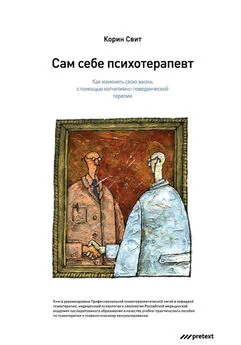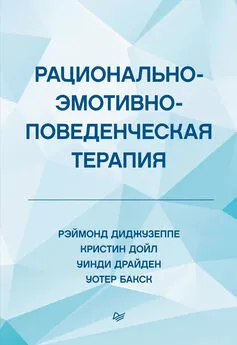Альберт Эллис - Практика рационально-эмоциональной поведенческой терапии
- Название:Практика рационально-эмоциональной поведенческой терапии
- Автор:
- Жанр:
- Издательство:РЕЧЬ
- Год:2002
- Город:Санкт-Петербург
- ISBN:5-9268-0120-6
- Рейтинг:
- Избранное:Добавить в избранное
-
Отзывы:
-
Ваша оценка:
Альберт Эллис - Практика рационально-эмоциональной поведенческой терапии краткое содержание
Книга изобилует реальными примерами из практики, иллюстрирующими применение РЭПТ в различных условиях, и предназначена для клинических психологов и консультантов, а также для всех, кто по роду своей деятельности помогает людям и интересуется терапией.
Практика рационально-эмоциональной поведенческой терапии - читать онлайн бесплатно полную версию (весь текст целиком)
Интервал:
Закладка:
105. *EllisA., 6r Knaus W. (1977> Overcoming procrastination. New YorkNew American Library.
106. * Ellis A., & Lange A. (1994). How to keep people frwn pushing your buttons. New York Carol Publications.
107. * Ellis A, Mclnemey J. R, DiGiuseppe R, 6r Yeager R /.(1988). Rational-emotive therapy with alcoholics and substance abusers. Needham, MA: Allyn & Bacon.
108. * Ellis A, & Robb H. (1994). Acceptance in rational-emotive therapy. In S. G Hayes, N. S. Jacobson, V. M Follette, & M.J. Dougher (Eds.), Acceptance and change (pp. 91— 102). Reno, NV? Context Press.
109. * Ellis A., Sicbel]., LeafR. С, & Mass R (1989). Countering perfectionism m research on clinical practice: 1. Surveying rationality changes afterasingle intensive RET intervention. Journal of Rational-Emotive and Cognitive-Behavior Therapy, 7,197–218.
110. * Ellis A., Sicbel J. L, Yeager R DiMattia D.J., & DiGiuseppe R A. (1989). Rational- emotive couples therapy. Needham, MA: Allyn & Bacon.
111. * Ellis A., 6r Velten E. (1992). When AA doesn’t work for you: Rational steps for quitting alcohol. New York: Barricade Books.
112. * Ellis A., 6r Wbiteley J. M. (1979). Theoretical and empirical foundations of rational- emotive therapy. Monterey, CA: Brooks/Cole.
113. * Ellis A., Wolfe J. L, 6r Moseley $. (1966). How to raise an emotionally healthy, happy child. North Hollywood, CA: Wilshire Books.
114. * Ellis A., &: Yeager R (1989). Why some therapies don4 work: The dangers of transpersonal psychology. Buffalo, NY: Prometheus.
115. Emmelkamp P. M. G., KuipersA. C.M., & EggeraatJ. B. (1978). Cognitive modification versus prolonged exposure in vivo: A comparison with agoraphobics as subjects. Behavior Research and Therapy, 16,33–41.
116. *Engels G. Gamefsld N. t 6r Dielcstra R E. W. (1993). Efficacy of rational-emotive therapy: A quantitative analysis. Journal of Consulting and Clinical Psychology, 61,1083–1090.
117. Epstein N., SchlesingerS. £., & Dtyden W. (Eds.). (1988). Cognitive-behavioral therapy with families. New York: Brunner/Mazel.
118. *Escbenroeder C. (1979). Different therapeutic styles in rational-emotive therapy. Rational Living, 14(1), 3–7.
119. Freud A. (1937). The ego and the mechanisms of defense. London: Hogarth.
120. Freud S. (1965). Standard edition of the complete psychological works of Sigmund Freud. London: Hogarth.
121. Golden W. L (1982). Rational-emotive hypnotherapy. International Journal of Eclectic Psychotherapy, 7(2), 47–56.
122. Golden W. L., Dowd E. T., & Friedberg E (1987). Hypnotherapy: A modern approach. New York: Pergamon.
123. Goldfried M. R, 6r Davison G. (1994). Clinical behavior therapy (2nd ed.). New York: Wiley.
124. *Grieger R M. (Ed.). (1986). Rational-emotive couples therapy (Special issue of Journal of Rational-Emotive Therapy). New York: Human Sciences Press.
125. * Grieger R, 6r Boyd J. (1980). Rational-emotive therapy: A skills-based approach. New York: Van Nostrand ReinholcL
126. *Grieger R, & Grieger /. (Eds.). (1982). Cognition and emotional disturbance. New York: Human Sciences Press.
127. * Grieger R M. t 6r Woods P.J. (1993). The rational-emotive therapy companion. Roanoke, VA: Scholars Press.
128. Guemey B. G., Jr. (1977). Relationship enhancement: Skill training programs for therapy, problem-prevention and enrichment San Francisco: Jossey Bass.
129. *Haaga D. A., 6* Davison G. C. (1989). Outcome studies ofrational-emotive therapy. In M. E. Bernard & R. DiGiuseppe (Eds.), Inside rational-emotive therapy, (pp. 155–197). San Diego, CA: Academic Press.
130. *Hajzler D., 6* Bernard M. E. (1991). A review of rational-emotive outcome studies. School Psychology Quarterly, 6(1), 27–49.
131. *Harpcr Я А. (1981). Limitations of marriage and family therapy. Rational Living, 16(2), 3–6.
132. Harris G. E (Ed.). (1977). The group treatment of human problems: A social learning approach. New York Grime & Stratton.
133. *Hauck P. A. (1973). Overcoming depression. Philadelphia: Westminster.
134. * Houck P. A. (1974). Overcoming frustration and anger. Philadelphia: Westminster.
135. * Houck P. A. (1977). Marriage is a loving business. Philadelphia: Westminster.
136. *Hauck P. A. (1981). Overcoming jealousy and possessiveness. Philadelphia: Westminster.
137. Houck P. A. (1983a). How to love and be loved. London: Sheldon Press.
138. *Hauck P. A. (1983b). Worldng with parents. In A. Ellis & M. E. Bernard (Eds.), Rational-emotive approaches to the problems of childhood (pp. 333–365). New York Plenum.
139. * Houck P. A. (1984). The three faces of love. Philadelphia: Westminster.
140. Houck P. (1991). Hold your head up high. London: Sheldon Press.
141. Heidegger M. (1949). Existence and being. Chicago: Henry Regnery.
142. HeimanJ. R, & LoPiccoIo J. (1988). Becoming orgasmic (rev. ed).New York Prentice-HalL
143. Hertzberg A. (1945). Active psychotherapy. New York Grune & Stratton.
144. Holton S. D., 6r Beck A. T. (1994); Cognitive and cognitive-behavioral therapies. In A. E Bergin & S. L Garfield (Eds.), Handbook of psychotherapy and behavior change (pp. 428–466). New York Wiley.
145. Homey K. (1950). Neurosis and human growth. New York Norton.
146. * Huber С. H., 6r Borutb, L G. (1989). Rational-emotive and systems family therapy. New York Springer Publishing Co.
147. Jacobson E . (1938). You must relax. New York McGraw-Hill.
148. Jacobson N. S. (1992). Behavioral couple therapy: Anew beginning. Behavior Therapy, 23,491–506.
149. Jakubowski-Spector P. (1973). Facilitating the growth of women through assertive training. Counseling Psychologist, 4(1), 75–86.
150. Jams 1. L (1983). Short-term counseling. New Haven, CT: Yale University Press.
151. Jones AL C. (1924). A laboratory study of fean The case of Peter. Journal of Genetic Psychology, 31,308–315.
152. Kaplan H. S. (1974). The new sex therapy. New York Brunner/Mazel.
153. Kelly G. (1955). The psychology of personal constructs (2 vols.). New York N orton.
154. Kendall P. 6r Hotbn, S. (Eds.). (1980). Assessment strategies for cognitive-behavioi-al interventions. New York Academic Press.
155. *Knaus W.J. (1974). Rational-emotive education. New York Institute for Rational- Emotive Therapy.
156. Korzybski A. (1933). Science and sanity. San Francisco: International Society of General Semantics.
157. *Lange A. J. (1979). Cognitive-behavioral group therapy and assertion training. In D. Upper & S. M Ross (Eds.), Behavioral group therapy. Champaign, IL: Research Press.
158. *LangeA, & Jakubowski, P. (1976). Responsible assertive behavior. Champaign, IL: Research Press.
159. Lazarus A. A. (1984). In the mind's eye. New York Guilford.
160. Lazarus A. A. (1985); Marital myths. San Luis Obispo, CA: Impact
161. Lazarus A. A. (1989). The practice of multimodal therapy. Baltimore: Johns Hopkins.
162. Lazarus R S, Sr Fotbnan S. (1984). Stress, appraisal, and coping. Mew York: Springer Publishing Co.
163. Lederer W.J., Sr Jackson D. D. (1968). The mirages of marriage. New York: Norton.
164. Lctblum S. R, Sr Rosen R C. (1989). Principles and practice of sex therapy (2 nded) New York: Guilford.
165. Levant R (1978). Family therapy: A client-centered perspective. Journal of Marriage and Family Counseling, 4(2), 35–42.
166. LoPiccolo J„Stewart R, Sr Watkins B, (1972). Treatment of erectile failure and ejaculatory incompetence with homosexual etiology. Behavior Therapy, 3,1–4.
167. * Lyons L G, Sr Woods P.J. (1991). The efficacy of rational-emotive therapy: A quantitative review of the outcome research. Clinical Psychology Review, II, 357–369.
168. MacasktHN. D., Sr MacasldU A.(1983). Preparing patients forpsychotherapy.British Journal of Clinical and Social Psychiatry, 2,80–84.
169. Mackay D. (1984). Behavioral 1psychotherapy. In W. Dryden (Ed), Individual therapy in Britain (pp. 264–294). London: Harper Sc Row.
170. Mackay D. (1985). Marital therapy: The behavioral approach. In W. Dryden (Ed); Marital therapy in Britain: Vol. 1. Context and therapeutic approaches (pp. 222–248). London: Harper Sc Row.
171. Mahoney M.J. (1991). Human change processes. New* York: Basic Books.
172. Margolin G., Sr Weiss, R 1. (1978). Comparative evaluation of therapeutic components associated with behavioral marital treatments. Journal of Consulting and Clinical< Psychology, 46,1476–1486.
173. Masters W., Sr Johnson V A. (1970). Human sexual inadequacy. BostonrLitde, Brawn.
174. Masters W. H., Johnson V £., Sr Kolodny R C. (1982). Human sexuality. Boston: Houghton Mifflin.
175. Maultsby M. C.,Jr, (1971)» Rational emotive imagery. Rational Living, 6(1), 24–27.
176. *MaultsbyM. C.,Jr. (1984). Rational behavior therapy. Englewood Cliffs, NJ: Prentice- Hall
177. *McCletlan T. A., Sr Stieper, D. R (1973); A structured approach to group marriage counseling, Rational Living, 8(2), 12–18*
178. *McGovem T. Б., Sr Sdverman M. & (1984). A review of outcome studies of rational’ emotive therapy from 1977to 1982.Journal of Rational-Emotive Therapy* 2(1), 7—18.
179. Meichenbaum D. (1992). Evolution of cognitive behavior therapy: Origins, tenets, and clinical examples. In J. K. Zeig (Ed)* The evolution of psychotherapy: Thesecond conference, (pp. 114–128)* New York Brunner/MazeL
180. Meichenbaum D., Gilmore J., Sr Fedoravicius A. (1971) Group insight versus group desensitization in treating speech anxiety. Journal of Consulting and Clinical Psychology, 36,410–421.
181. *МШег R C, Sr Berman J: 5. (1983) The efficacy of cognitive behavior therapies: A quantitative review of the research evidence. Psychological Bulletin, 94,39–53.
182. *МШег T. (1983) The unfair advantage. Manhus, NY: Author.
183. *Mdls D. (1993). Overcoming self-esteem.New York Institute for Rational-Emotive Therapy.
184. * Moore R H. (1983). Inference as "A" in RET. British Journal of Cognitive Psychotherapy, 7(2), 17–23.
185. Norcross J. C, Sr Prochaska J. 0. (1982) A national survey of clinical psychologists: Characteristics and activities* Clinical Psychologist, 35,1–8.
186. Otto Н. (1968). Group methods designed to actualize human potential. Chicago: Achievement Motivation Systems.
187. Peris E (1969). Gestalt therapy verbatim. Lafayette, CA Real People Press.
188. *?badke K. Ai (1982). Some innovations in RET theory and practice. Rational Living, 77(2), 25–30.
189. Popper K.R (1959). The logic of scientific discovery. New York Harper & Row.
Читать дальшеИнтервал:
Закладка:



![Альберт Эллис - Успокойся! Контролируй тревогу, прежде чем она начнет контролировать тебя [litres]](/books/1059831/albert-ellis-uspokojsya-kontroliruj-trevogu-prezh.webp)






